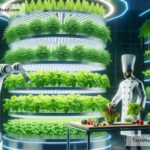The Future of Food and Transformative Governance: Shaping a Sustainable Tomorrow
Food is the cornerstone of human life. It nourishes our bodies, brings people together, and reflects diverse cultures around the world. But as the global population grows and environmental challenges mount, how we produce, distribute, and consume food must change to meet the needs of future generations. Equally important is the role of governance—how we make decisions about food systems and guide them toward sustainability and fairness. Let’s explore how the future of food and transformative governance can work hand in hand to shape a better world.
The Future of Food: Innovation for a Sustainable Planet
The way we grow, transport, and eat food today may not be sustainable in the future. Problems like soil degradation, over-reliance on water for irrigation, greenhouse gas emissions from agriculture, and food waste have pushed scientists, farmers, and entrepreneurs to rethink food systems. Creating solutions that make food healthier, more accessible, and environmentally friendly is the big challenge—and exciting opportunity—of the 21st century.
1. Alternative Proteins
One of the most groundbreaking changes in the future of food is the rise of alternative proteins. Instead of relying heavily on traditional sources like beef, chicken, and pork—which require large amounts of land, water, and feed—many companies are developing plant-based proteins, lab-grown meats, and insect-based foods. Brands like Beyond Meat and Impossible Foods have already created plant-based products that taste and feel like meat, while labs around the world are producing cultivated meat from animal cells. These innovations aim to reduce the environmental impact of meat production while offering protein-packed options to consumers.
2. Smarter Food Production
Technology is revolutionizing farming. Vertical farming, for example, allows crops to grow in stacked layers in controlled environments, using less water and space than traditional farms. Precision agriculture uses drones, sensors, and artificial intelligence to monitor soil, track plant health, and apply fertilizers exactly when and where they’re needed. This reduces waste while boosting productivity.
3. Climate-Resilient Crops
As climate change disrupts rainfall patterns and temperatures, scientists are engineering crops that can survive harsher conditions. These climate-resilient crops might require less water or be more resistant to pests and diseases. With such innovations, farmers can grow food even in environments that were previously unsuitable for agriculture.
4. Reducing Food Waste
Globally, one-third of all food produced is wasted. New technologies and systems aim to fight this problem. For example, apps now connect restaurants, grocery stores, and households with surplus food to people in need, keeping edible food out of landfills. Advances in packaging, storage, and transportation are also extending the shelf life of foods.
Transformative Governance: Building Fair and Inclusive Food Systems
Technology alone cannot solve the challenges facing food systems. We need smart governance—policies, rules, and frameworks—to guide these changes and ensure they benefit everyone, not just a privileged few.
1. Prioritizing Food Security
Governments around the world are working to make sure everyone has enough to eat. Policies like subsidized food programs, community gardens, and food banks ensure that marginalized communities have access to healthy meals. In the future, leaders will need to think creatively about how to increase food security for growing populations while managing dwindling resources.
2. Encouraging Local Food Systems
Depending heavily on imported food can make countries vulnerable to supply chain disruptions, like those caused by pandemics or natural disasters. Strengthening local food systems—such as supporting small-scale farmers and promoting urban agriculture—helps reduce reliance on imports. Local food systems can also offer fresher produce and support regional economies.
3. Regulating Emerging Technologies
With advances in food technology, governments will play a crucial role in ensuring new products are safe, accessible, and fair. For example, lab-grown meat might need clear labeling laws and ethical frameworks to address concerns about animal welfare, affordability, and cultural acceptance. Regulations must strike a balance between encouraging innovation and protecting consumers.
4. Involving Communities in Decision-Making
Transparency and collaboration are key to transformative governance. When local communities have a say in food policy, governments can better align their decisions with the needs of the people. Participatory models, such as citizen assemblies or farmer advisory boards, allow diverse voices to shape the future of food systems.
5. Promoting Climate-Friendly Policies
Governments have the power to guide food production toward sustainability. Subsidies for eco-friendly farming practices, taxes on high-emission agricultural methods, and investments in renewable energy for farms can help reduce food-related greenhouse gas emissions. International cooperation will also be necessary to address global problems like deforestation and overfishing.
Working Together for a Bright Future
The future of food depends on collaboration. Scientists, farmers, businesses, and governments must work together to create food systems that are productive, equitable, and sustainable. Consumers also play an active role by choosing environmentally conscious products, reducing food waste, and advocating for better food policies.
The road ahead is challenging, but it’s filled with hope and potential. With transformative governance steering innovation in the right direction, we can ensure that future generations have access to nourishing food while protecting our planet. By rethinking how we grow, share, and eat, we can build a brighter future for everyone.


